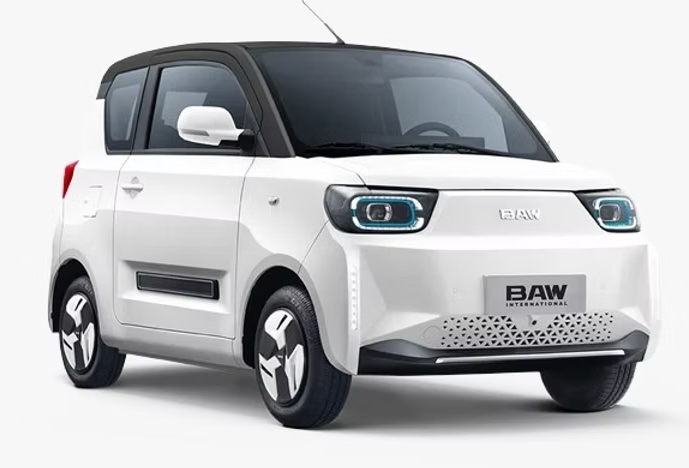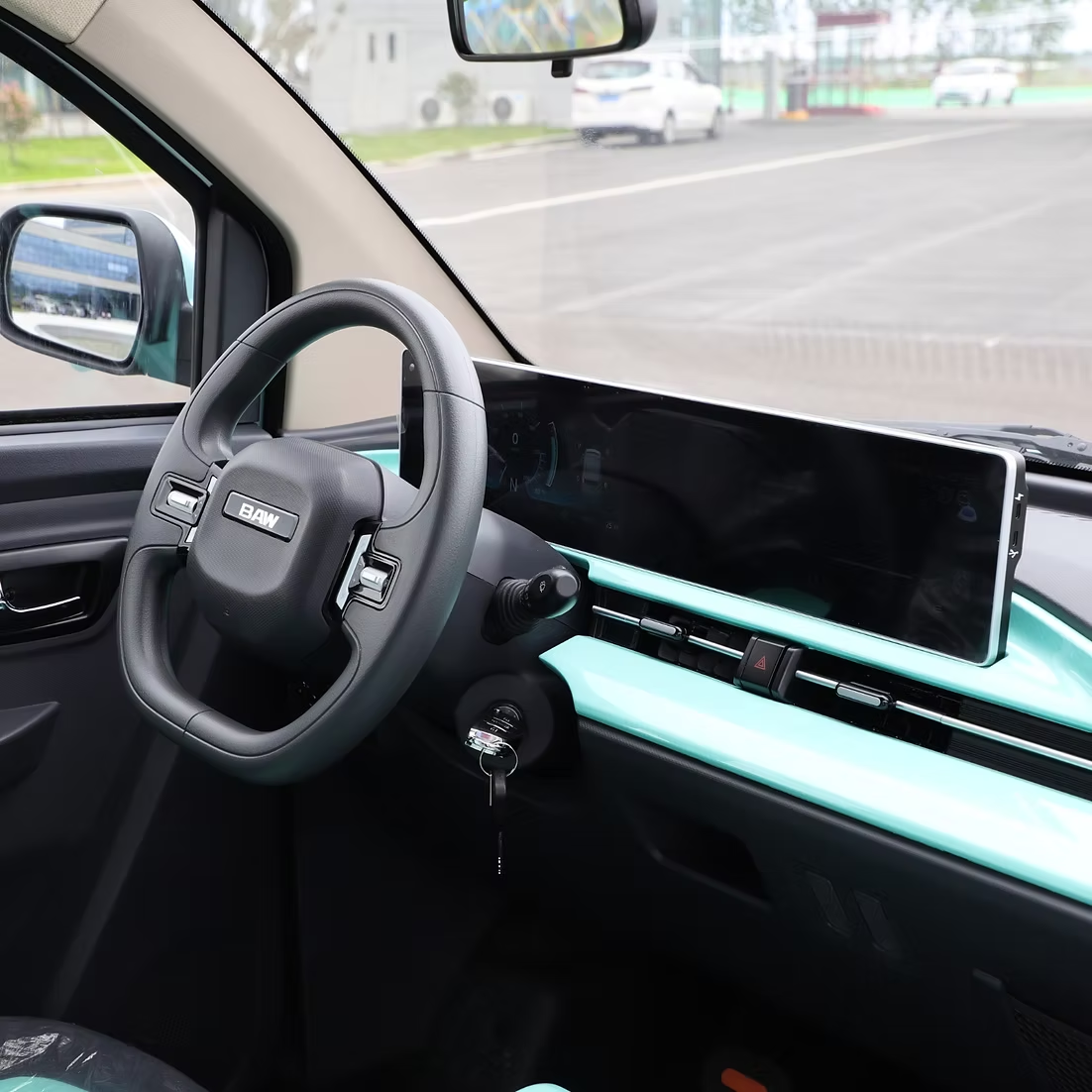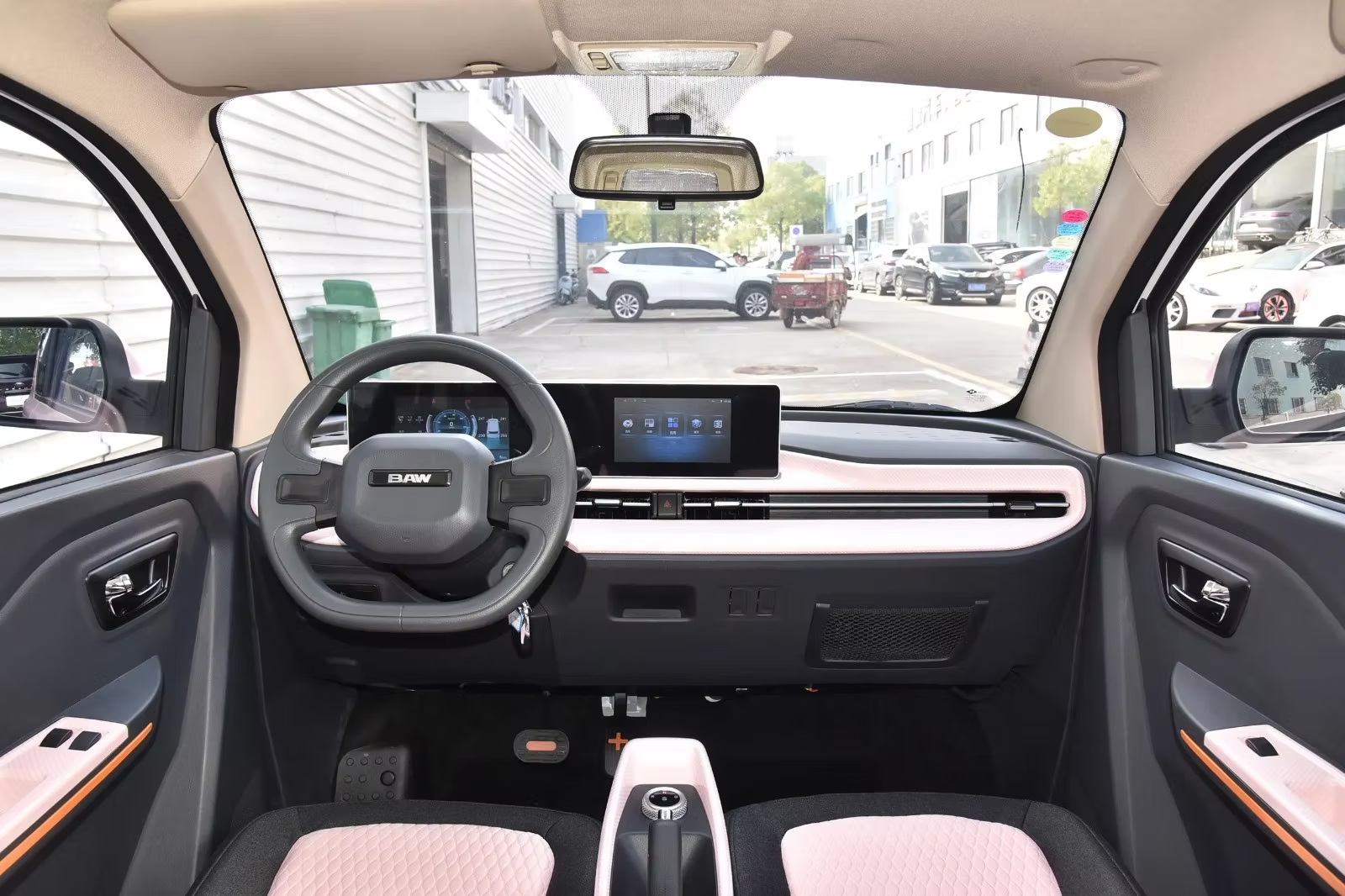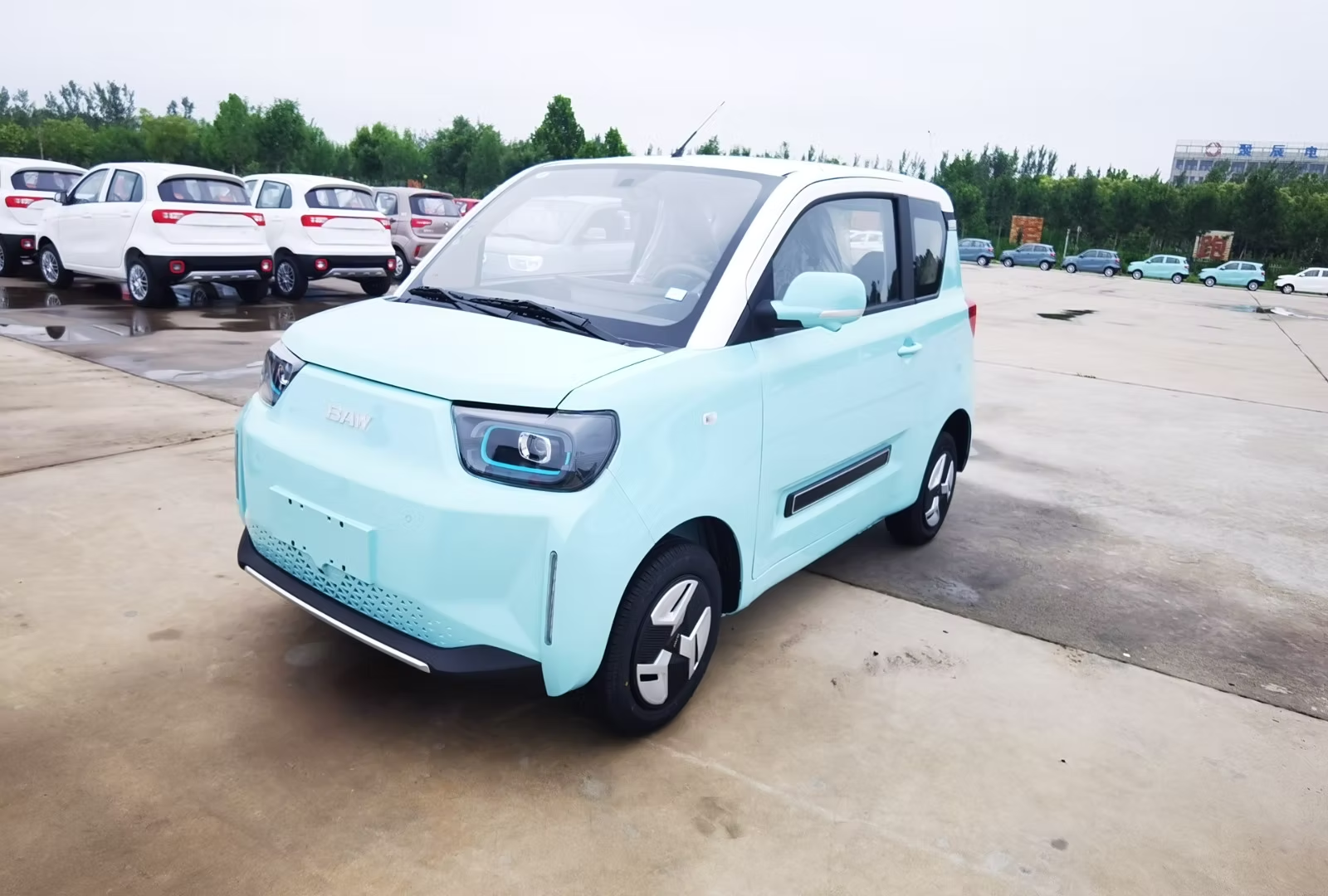




Equipped with an extensive feature set (driver airbag, ABS/CBS/EBD, 360° driving and parking sensors, 360° cameras, air conditioning, 10.25″ multimedia screen, and more), a 6-year warranty on its iron phosphate battery, up to 220 km range, and a top speed exceeding 100 km/h—all at an unbelievable price! What more could you ask for in a high-quality city microcar? Order yours today from the experts at BAUER ENERGY!
This compact electric vehicle is not just for city driving. Even on short trips outside the city, the BEEV-4 Pony won’t let you down. With an impressive range of up to 220 km, it ensures reliable mobility for you and three passengers. This city microcar stands out not only for its advanced electric technology but also for its comfort and practicality.
Thanks to its enclosed design, this microcar is the ideal transportation option—whether on warm, dry days or during cold, rainy weather. The built-in air conditioning ensures a refreshing cool breeze, while the heater warms up the cabin in just a few minutes.
No more trips to the gas station! Simply plug the included charging cable into a standard 230V household outlet, and in just 6 hours, your BEEV-4 Pony will be ready for your next journey.
With optimized weight and electric drive technology, the BEEV-4 Pony offers a cost-effective range of up to 220 km. With an operating cost of just ~€2.50 per 100 km, it sets a new standard compared to traditional internal combustion engines. No hidden costs—state-of-the-art LFP batteries are already included in the purchase price.
Equipped with a driver airbag, ABS+ESP, and built-in regenerative technology, the BEEV-4 Pony delivers both safety and driving enjoyment. Regenerative braking recovers energy during braking, boosting vehicle efficiency by converting kinetic energy back into electricity.
When you purchase the BEEV-4 Pony, you’re not just getting an electric vehicle—you’re also getting long-term support. Spare parts are readily available, and our service centers handle maintenance, repairs, and custom modifications for your microcar, ensuring ongoing expert support even after your purchase.
Take advantage of:
✔ Tax incentives under Law 4710/2020
✔ A €3,000 state subsidy
and make the best purchase ever!
Dimensions (LxWxH): 3060x1480x1585 mm
Wheelbase: 2050 mm
Ground clearance: 145 mm
Weight (including battery): 645 kg
Seats: 4
Type: 3-phase AC synchronous motor
Power: 13 kW (4,800 rpm) / 15 kW (4,800 rpm)
Nominal voltage: 102V / 115V
Batteries (LFP): 13.7 kWh / 17.3 kWh
Charging voltage: 230V AC
Differential: Automatic
Drive system: Rear-wheel drive
Front suspension: McPherson struts
Rear suspension: Semi-independent
Brakes: Front discs, rear drums
Parking brake: Handbrake
Wheels: Steel or aluminum R13
Tires: 155/65 R13
Energy consumption (loaded): 122 Wh/km / 98 Wh/km
Max speed: 90 km/h
Max climbing angle: >20%
Full charge time: 6-8 hours
Range: Up to 170 km / 220 km
✔ Central locking
✔ 10.25″ Multimedia screen
✔ Driver airbag
✔ ABS / EBD / EPS / HAC / BOS
✔ Air conditioning
✔ Tire Pressure Monitoring System (TPMS)
✔ Electronic traction control
✔ Multiple collision avoidance system
✔ Collision warning with visual/audio alert
✔ 4-way adjustable seats
✔ Fully foldable rear seat
✔ 12V power outlet
✔ LED daytime running lights
✔ Rearview camera
✔ Android Auto compatibility
✔ Bluetooth, radio, video, apps
✔ 3-point seat belts
✔ 360° driving & parking sensors
✔ 360° driving & parking cameras
✔ Side reflector
✔ Electric adjustable mirrors
✔ Electric windows
✔ Sun visors for driver & passenger
✔ Electric power steering
✔ Trunk opening via remote key
LFP 13.7 kWh: Up to 170 km
LFP 17.3 kWh: Up to 220 km
ANTECO Rent Cars
We firmly believe that the internet should be available and accessible to anyone, and are committed to providing a website that is accessible to the widest possible audience, regardless of circumstance and ability.
To fulfill this, we aim to adhere as strictly as possible to the World Wide Web Consortium’s (W3C) Web Content Accessibility Guidelines 2.1 (WCAG 2.1) at the AA level. These guidelines explain how to make web content accessible to people with a wide array of disabilities. Complying with those guidelines helps us ensure that the website is accessible to all people: blind people, people with motor impairments, visual impairment, cognitive disabilities, and more.
This website utilizes various technologies that are meant to make it as accessible as possible at all times. We utilize an accessibility interface that allows persons with specific disabilities to adjust the website’s UI (user interface) and design it to their personal needs.
Additionally, the website utilizes an AI-based application that runs in the background and optimizes its accessibility level constantly. This application remediates the website’s HTML, adapts Its functionality and behavior for screen-readers used by the blind users, and for keyboard functions used by individuals with motor impairments.
If you’ve found a malfunction or have ideas for improvement, we’ll be happy to hear from you. You can reach out to the website’s operators by using the following email
Our website implements the ARIA attributes (Accessible Rich Internet Applications) technique, alongside various different behavioral changes, to ensure blind users visiting with screen-readers are able to read, comprehend, and enjoy the website’s functions. As soon as a user with a screen-reader enters your site, they immediately receive a prompt to enter the Screen-Reader Profile so they can browse and operate your site effectively. Here’s how our website covers some of the most important screen-reader requirements, alongside console screenshots of code examples:
Screen-reader optimization: we run a background process that learns the website’s components from top to bottom, to ensure ongoing compliance even when updating the website. In this process, we provide screen-readers with meaningful data using the ARIA set of attributes. For example, we provide accurate form labels; descriptions for actionable icons (social media icons, search icons, cart icons, etc.); validation guidance for form inputs; element roles such as buttons, menus, modal dialogues (popups), and others. Additionally, the background process scans all the website’s images and provides an accurate and meaningful image-object-recognition-based description as an ALT (alternate text) tag for images that are not described. It will also extract texts that are embedded within the image, using an OCR (optical character recognition) technology. To turn on screen-reader adjustments at any time, users need only to press the Alt+1 keyboard combination. Screen-reader users also get automatic announcements to turn the Screen-reader mode on as soon as they enter the website.
These adjustments are compatible with all popular screen readers, including JAWS and NVDA.
Keyboard navigation optimization: The background process also adjusts the website’s HTML, and adds various behaviors using JavaScript code to make the website operable by the keyboard. This includes the ability to navigate the website using the Tab and Shift+Tab keys, operate dropdowns with the arrow keys, close them with Esc, trigger buttons and links using the Enter key, navigate between radio and checkbox elements using the arrow keys, and fill them in with the Spacebar or Enter key.Additionally, keyboard users will find quick-navigation and content-skip menus, available at any time by clicking Alt+1, or as the first elements of the site while navigating with the keyboard. The background process also handles triggered popups by moving the keyboard focus towards them as soon as they appear, and not allow the focus drift outside it.
Users can also use shortcuts such as “M” (menus), “H” (headings), “F” (forms), “B” (buttons), and “G” (graphics) to jump to specific elements.
We aim to support the widest array of browsers and assistive technologies as possible, so our users can choose the best fitting tools for them, with as few limitations as possible. Therefore, we have worked very hard to be able to support all major systems that comprise over 95% of the user market share including Google Chrome, Mozilla Firefox, Apple Safari, Opera and Microsoft Edge, JAWS and NVDA (screen readers).
Despite our very best efforts to allow anybody to adjust the website to their needs. There may still be pages or sections that are not fully accessible, are in the process of becoming accessible, or are lacking an adequate technological solution to make them accessible. Still, we are continually improving our accessibility, adding, updating and improving its options and features, and developing and adopting new technologies. All this is meant to reach the optimal level of accessibility, following technological advancements. For any assistance, please reach out to